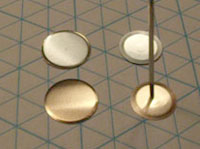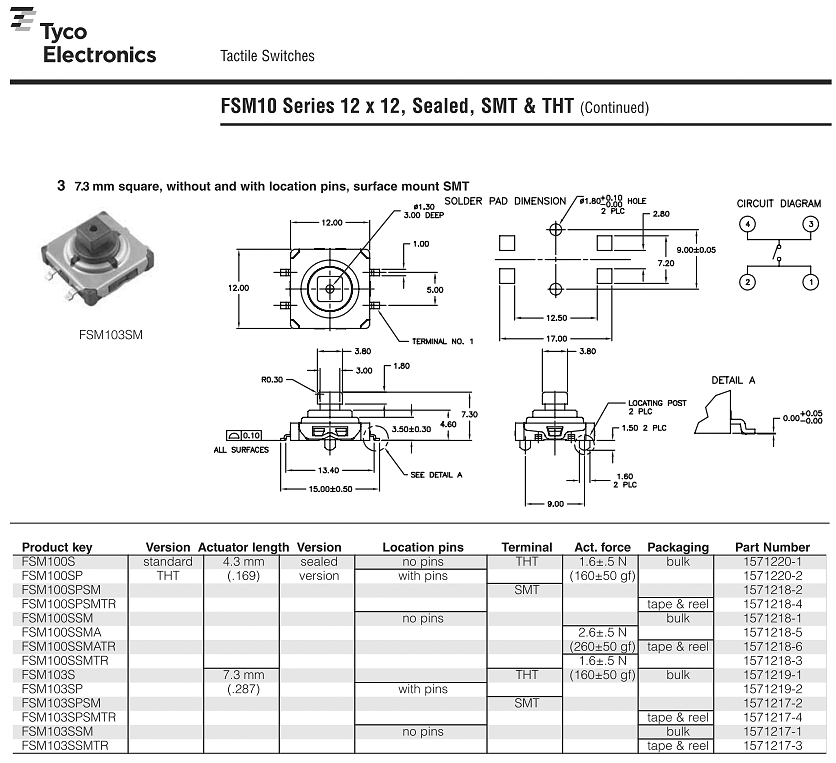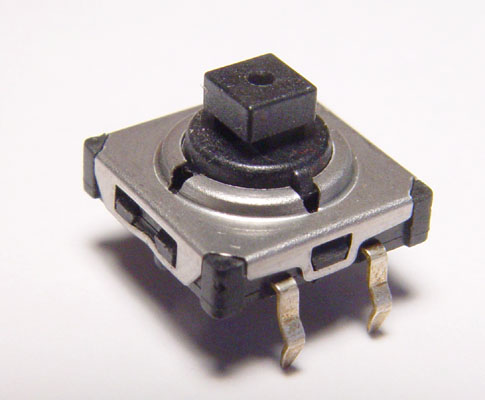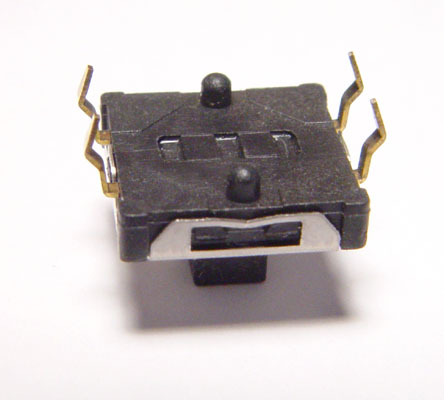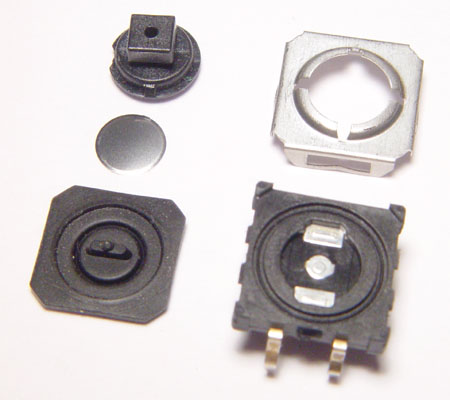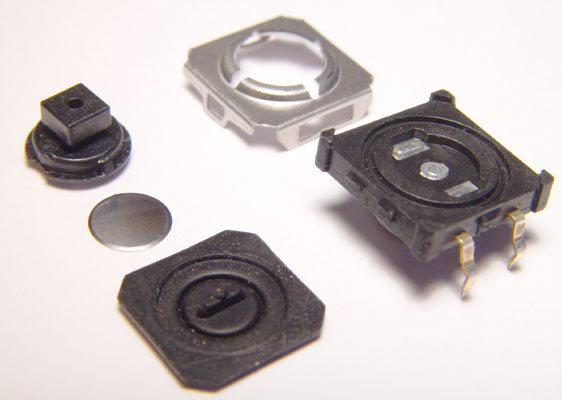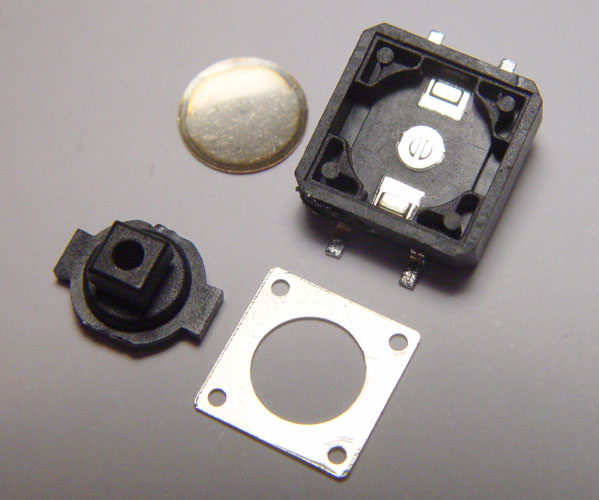
Comparing 4 types of tact switch: ALPS unsealed, ALPS sealed, Omron sealed and TE sealed
Established in September to October 2010, for the ALPS and Omron switches (Part 1)
I decided that the Omron sealed tact switches were a better choice than the ALPS ones.
Part 2 -Extended to cover the TE sealed tact switches in May 2015 (Part 2)
I am also interested in replacements for the Cyclone Analogic Bass Bot (TT-303), which uses surface mount unsealed tact switches. The TE ones have stems which are too small for the Bass Bot buttons. There is a workaround for this, but the best option I know of at present is to adapt the Omron sealed switches for surface-mount (Omron doesn't make SMT sealed 12mm tact switches).
Robin Whittle rw@firstpr.com.au
Part 1: Comparing 3 types of tact switches (ALPS and Omron)
This section was written in September to October 2010 and has not been updated since.Introduction
That page also contains a datasheet for the Omron switches.
Since August 2010, we are installing the modified Omron switches in Devil Fishes. As a service to people who want to replace their own switches, we are also selling packs of modified Omron switches. Please see these sections of the main Devil Fish page:
Since our choice of Omron switches implies a criticism of the use
of the original unsealed ALPS switches, or the other alternative –
sealed ALPS switches – and since the reliability of these switches is
so important, I have created this page to give people some insight into
the characteristics of these switches, and why we chose the Omron
switches.
An update history is at the end: #updates
.
Dust appears to cause tact switch failure
Before mid-2010, starting with the first Devil Fishes in 1993, I
installed the original kind of unsealed ALPS tact switch, with a "dust
guard" – a thin mylar sheet with holes punched in it for the switch
stems and LEDs. (The plastic was from a 3M overhead transparency
protector.) This greatly prolonged the life of the switches – I
guess by a factor of 5 or 10.
The failure mode of these switches
is that they become erratic and "bounce" – more than one open-close
transition when pressing or releasing the switch, as detected by
whatever de-bounce algorithm which is implemented in the TB-303's CPU's
firmware. As far as I can tell, the reason is that dust, I guess mainly
100% protein flakes of skin, get inside the switch and are compacted
into thin layers on both the stationary contact and the moving metal
contact which clicks down against it. With a badly bouncing
switch, the coating is thin and appears to be
transparent. It is visible under a stereo microscope, and easily
removed once the switch is dismantled. I have seen no sign of
corrosion or actual wearing of the metal contacts. The
switches, once dismantled, can't be re-assembled, so this is not a
method for fixing erratic switches. They must be replaced.
The dust guard reduces the amount of dust around the switch which
can enter via the circular gap between the moving shaft and the metal
ring in
the body of the switch. This lends support to my theory that dust
is the cause of failure, since the dust guard can't affect any
corrosive elements in the atmosphere, or the actual mechanical movement
of the switch. The electrical current in the TB-303 switch
scanning circuit is very low – about 0.3mA, with an open-circuit
voltage of about 5V. I think this is probably too low to "self-clean" the
contacts, by way of a little spark or similar.
Perhaps increasing the drive current, by altering the 15k resistors R223, R219,
R218 and R48, say to 1k or 2.2k, would introduce some kind of
self-cleaning current. I have never tried this. It is
difficult to anticipate the long-term impact of this, since perhaps
that process would also erode the metal surface, leading to corrosion
or other problems.
However, there were some instances of these replaced switches becoming erratic after 7 to 10 years, at least with the machines which were intensively used. Ideally, we would replace the switches and no-one would have to worry about replacing them for decades, even if the machine is intensively used.
Searching for alternatives
During this time, I became aware of the sealed ALPS tact switches and purchased 100 of them. I found they had a very poor feel compared to the original unsealed ALPS switches and the Omron switches. There was little travel in the "click" operation, and little difference between the force required to activate the click and that required to hold the switch closed once it was in the down state. (This was not a bad batch of switches. I was later sent some of these switches by someone who sells them, and they feel identical to the ones I tested.)
I kept two of these switches and returned the remainder.
I can't be absolutely sure these Omron switches will last a long time. However, their datasheet specifies their life as 3 million operations. There's no specification for what this means, but this is a high number for a switch.
I think that as long as dust is excluded, and the switches are not exposed to a corrosive atmosphere, then they will last a very long time. The Omron switches are completely sealed against dust and liquids.
Summary of results
The short version is that the Omron sealed tact switches have a very good click feel, at least as good as the original unsealed ALPS switches. They involve a somewhat higher activation force, but I think that is fine.
The sealed ALPS switches which we purchased had, in our opinion, a much poorer click action. The travel was much smaller and there was less difference between the activation force and the holding force: that required to hold the switch closed in the downwards position before it snaps up.
According to the spec sheets, both the original and the sealed ALPS switches have the same travel: 0.3mm. However, our experience is that the sealed ALPS switches have a much shorter travel between the point where they snap downwards, and the downwards position.
I intend to obtain some sealed ALPS switches from someone who is happy with them. When I do, I will update this page to confirm or reject the possibility that the sealed ALPS switches we tested behaved differently from the switches that this supplier, and his customers, are apparently happy with.
If you accept our choice – if you lack a profound curiosity about the inner workings and behaviour of tact switches – then there's probably no reason to read further.
In early September 2010, I did some simple tests on the switches and put them up on the 303-mods page. These tests, of activation and holding forces, were in accordance with our judgment about the clicking actions of these switches.
A few days later, I figured out a way of doing better tests. The results of those tests are detailed below. I removed the earlier test results from the 303-mods page.
The most important results can be summarised, but first a few terms I invented for these tests:
- Activation force. The force required to almost bring the
switch to the point where it clicks to the downwards state. This
is measured in Newtons, where 1 Newton is the force exerted by the
Earth's gravity, at sea-level, on an object whose mass is about 102
grams.
- By the time this activation force is applied, the stem will have
moved somewhat from its zero force position. This movement is
what I call the "Initial Displacement".
- Holding force. Once the switch is in the downwards state,
the force which is required to keep it down. This is less than
the activation force, due to the snap-action hysteresis of the
switch. Once a force less than this is applied, the switch snaps
back to the up position. That new "up" position is not necessarily fully
up, as with no force, and it may be marginally higher than when the
activation force is applied in the Up state.
- Delta force = Activation force - Holding
force. This is how much force must be removed after pressing the
switch down with the Activation force, before it will snap up.
- Delta
ratio, as a percentage = 100 * Delta force / Activation force.
This is the ratio of the Delta force as a fraction of Activation force.
- Click displacement. The distance between the position just mentioned – with the Activation force, or just a little less, applied –
and the Down position after the switch has clicked, and a force similar
to the Activation force is still being applied. The stem may go
down further
with greater pressure (probably only the Omron sealed switch would do
this, since it involves a thin synthetic rubber sheet transmitting the
force), but this "Click displacement" is the distance we feel the
stem fall when the switch clicks.
Here is a summary of the most important measurements. "mN" means milli-Newton.
| |
Original unsealed ALPS |
Sealed ALPS |
Sealed Omron |
| Activation force |
1243 mN |
1595 mN |
1484 mN |
| Holding force |
605 mN |
1305 mN |
764 mN |
| Delta force |
638 mN |
290 mN |
720 mN |
| Delta ratio |
51.3% |
18.2% |
48.5% |
| Initial displacement |
0.148mm |
0.123mm |
0.164mm |
| Click displacement |
0.230mm |
0.125mm |
0.234mm |
Please note that these tests were not done in a fancy laboratory and did not attempt to sample multiple batches of switches. The force measurements for the sealed ALPS switches were based on two switches and the displacement measurements were based on one of these switches.
The figures in red show how different the sealed ALPS switches (at least the ones I tested) were from the other two types:
The Holding force was much higher – nearly twice that of the other two switches.
The Delta force was less than half that of the other two switches.
The ratio of the Delta force to the Activation force was much lower: about 38% of that of the Omron switch and about 35% of that of the unsealed ALPS switch.
The Click displacement was much less – only about 55% of that of the others.
I tested 10 unsealed ALPS switches for forces, and chose two of them with close to average forces for the displacement tests. I used 10 sealed Omron switches in the same way. I only have two sealed ALPS tact switches, and one of them I had partially dismantled. So I used those two for the force tests, and the non-dismantled one for the displacement tests.
Even allowing for variation between batches, the differences between the ALPS sealed switches and the other two types are highly significant, and explain why we felt their click action was so poor.
Maybe some people like a lower Click displacement and lower Delta force, but we don't.
Details of the switches
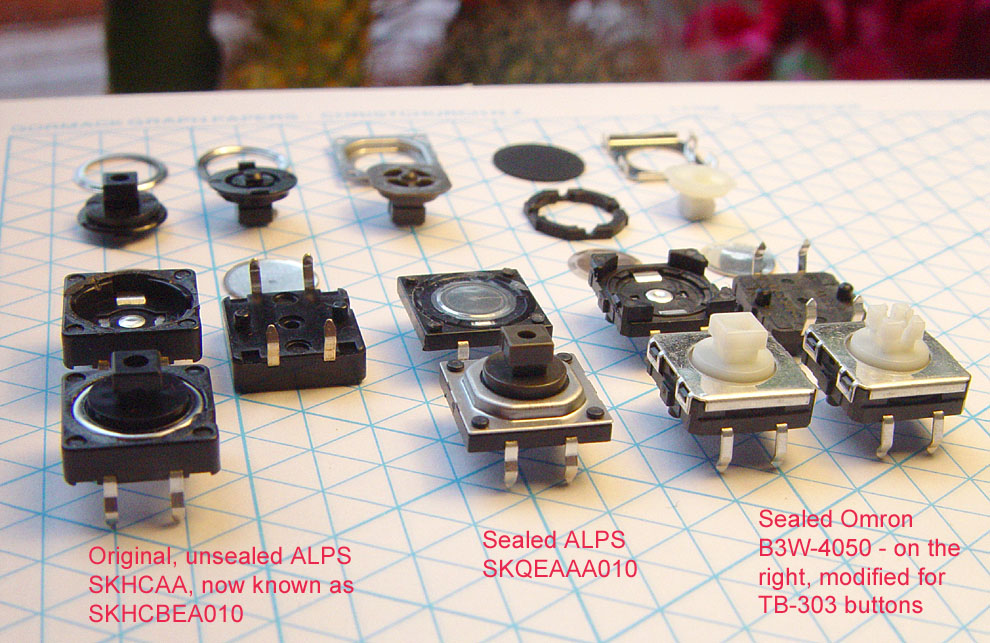
- ALPS unsealed tact switch SKHCBEA010, previously known as SKHCAA. These are the same as were used in the TB-303, and are still in mass production nearly 30 years later. URL
Force: 1.27 Newton (~130 grams)
Travel: 0.30mm
Operating life (5V, 5mA): 1,000,000 cycles
- ALPS sealed tact switch SKQEAAA010. URL
Force: 1.57 Newton (~160 grams)
Travel: 0.30mm
Operating life (5V, 5mA): 10,000,000 cycles
- Omron sealed tact switch B3W-4050. URL Datasheet archives here: ../303-mods/Omron-Tact-Switches-2010-B3W_1109.pdf .
Operating force (max): 160 grams (~1.57 Newtons)
Release force (min): 30 grams (~0.29 Newtons)
Pretravel 0.29 to 0.32mm
Service life (min): 3,000,000 operations
Width of top of stem: 3.8mm +/- 0.1mm. (But I measure 3.84 to 3.33mm in one dimension and 3.83 to 3.82mm in the other.)
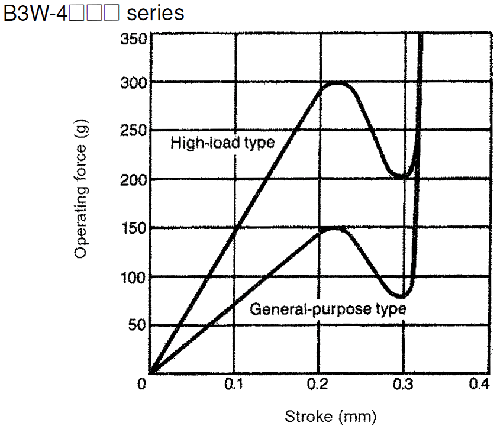
The lower curve applies to the B3W-4050. I am pretty sure that these curves are an artist's impression. The real displacement is less on the way to 150 grams: 0.164mm. Then (according to our tests), the switch snaps and goes towards the bottom of its travel, which takes it another 0.234mm, for a total travel of about 0.4mm.
Here are some pictures of the insides of the switches.
They all operate by the centre of the spring disc (phosphor bronze or beryllium copper, I assume) popping inwards, inverting its normal concave shape. Here is a 15 second video of popping some isolated discs. (Sorry about the erratic brightness.)
Each of the 4 videos on this page is available in two formats: 3GP and Real Video. Both of them play OK with the free version of Real Player for Windows XP: http://www.real.com . Please let me know if you have any difficulty viewing the videos.
Here are some more photos of the switches.
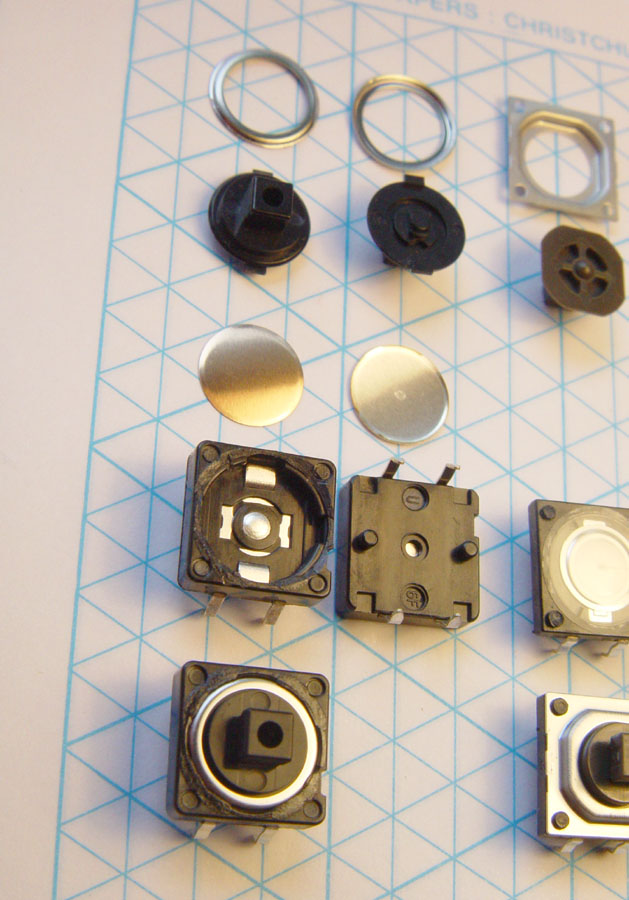
The unsealed ALPS switch has its stem with a cylindrical flat-bottom plunger, which presses directly against the top of the disc. The disc is shown in its normal orientation (curve up) on the left, and upside-down, to show the contact surface on the right. While the centre of the disc pops in, the disc doesn't pop inside out. So it is still being pressed against the two contacts at the top and bottom of the circular cavity, while, in its down state, the centre of the disc (which is plated with something more silvery) is also pressing against the centre contact.
The sealed ALPS switch on the right has its disc entirely enclosed by a thin adhesive plastic cover. The plunger at the bottom of the stem has a hemi-spherical shape, and presses against the plastic sheet, which is stuck to the disc. So the sealed switch has a more acutely focused force on its metal disc than the unsealed one.
The plastic seal looks like it would do a good job of keeping out dust and any liquid which didn't dissolve the adhesive. I imagine the hemi-spherical plunger would soon wear a hole in the plastic, but that wouldn't affect the operation of the switch, or the sealing against dust and liquids, since the entire bottom surface of the plastic is adhesive, and so it is stuck to most of the top of the disc.
(BTW, the groovilicious triangular graph paper is "L110X Isometric grid", by Gormack Graph Papers, Christchurch New Zealand. I think it is from the late 70s or early 80s.)
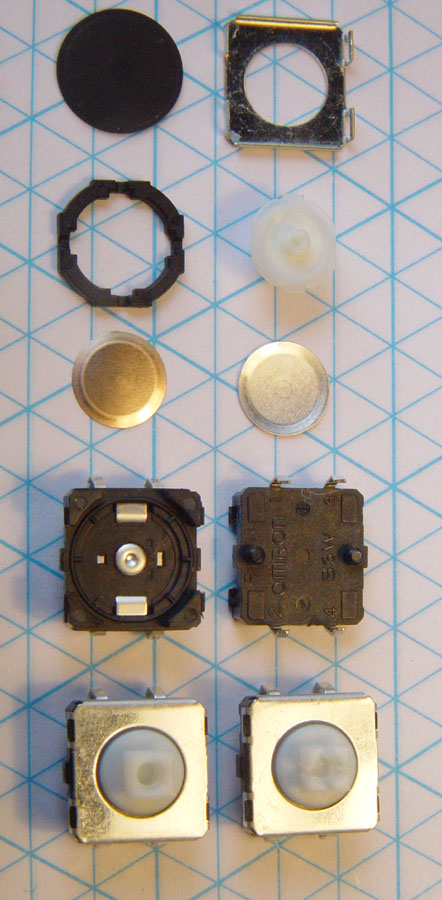
This is the Omron sealed switch, with the one on the right modified so it fits TB-303 buttons.
The black circle is a disc of 0.4mm synthetic rubber, or similar. The bottom of the stem has a circular plunger, which presses against this rubber, and the rubber presses against the centre of the disc.
This circular plunger would spread out the load more than the hemi-spherical plunger of the ALPS sealed switch. I assume that this design will not involve erosion of the rubber sheet. If enough force was placed on the stem, often enough, I am sure this would occur. However, there's no need for people to press the buttons with much more than the activation force.
At first I thought the rubber disc doesn't seem to be pressed especially hard onto the circular edge of the main body of the switch, by the black plastic ring and the metal retaining clip. However . . .
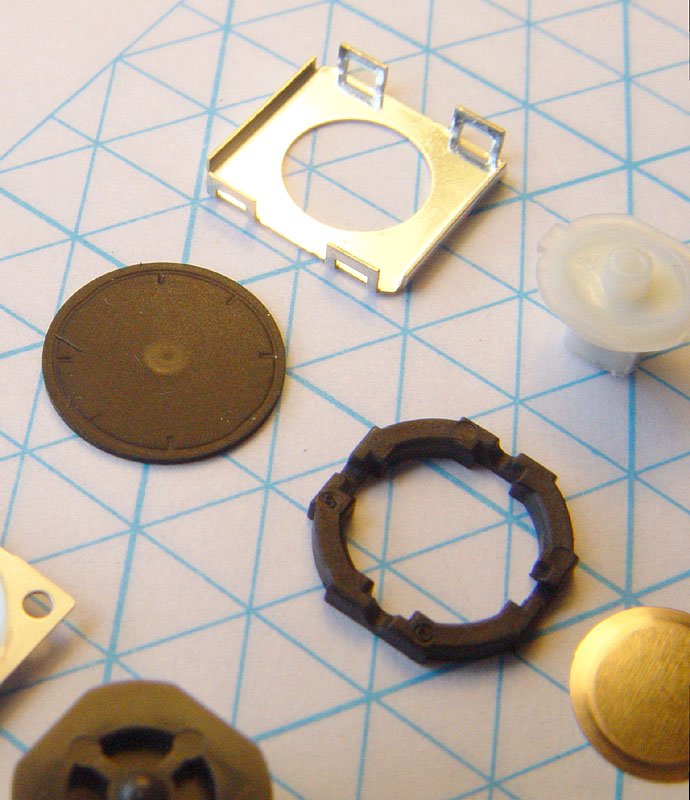
. . . this picture shows the underside of the rubber disc indented from being pressed into the circular cavity in the switch body. It is pressed down by the black plastic ring above it, which is in turn held down by the metal frame.
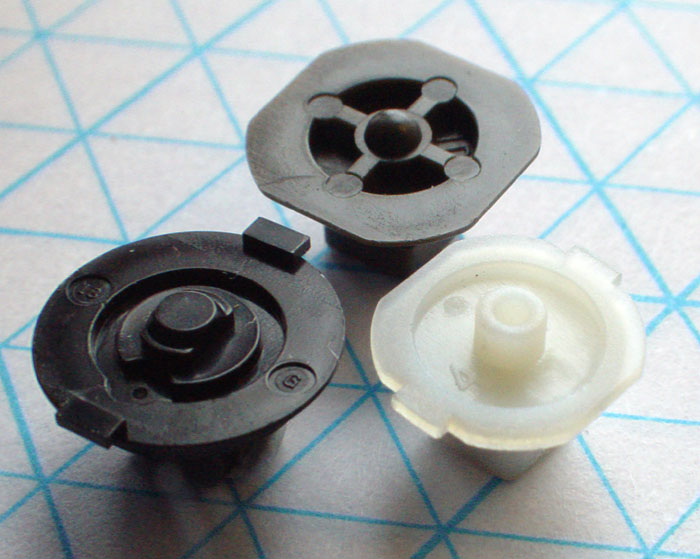
From left to right: flat cylindrical plunger of the unsealed ALPS switch, hemi-spherical plunger of the ALPS sealed switch and the circular plunger of the Omron switch.
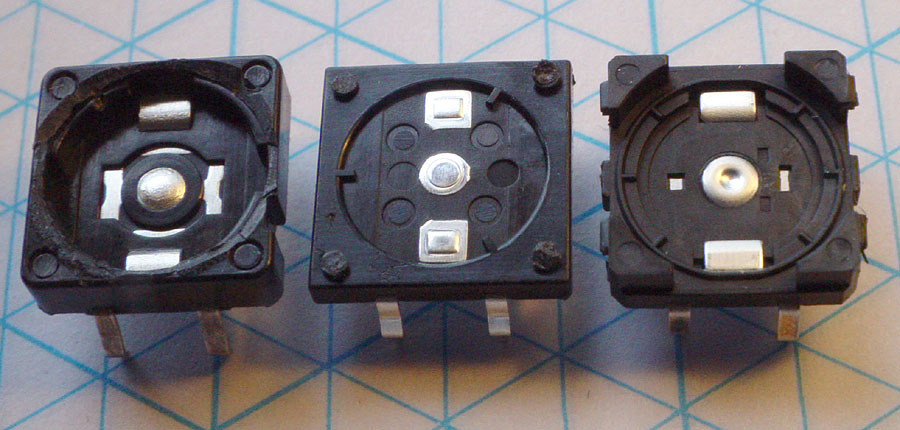
The centre contact of the Omron switch is circular, with a depression in the middle – very different from the broadly round centre contacts of the ALPS switches.
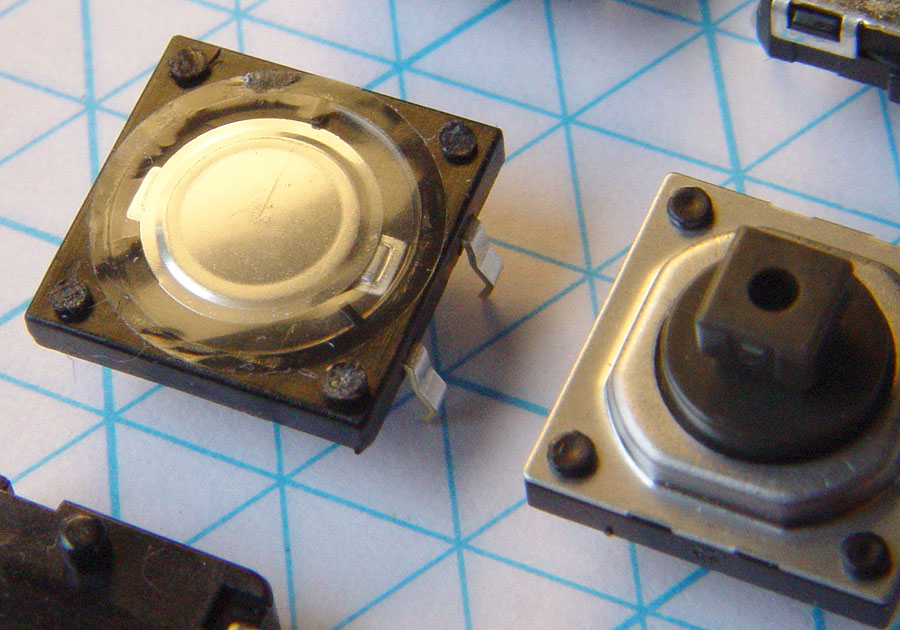
Here is a close-up of the sealed ALPS switch, with its stem removed. I have previously pulled this adhesive plastic off, so this is not exactly what it would look like. There are three pieces of plastic to hold the disc in the right position.
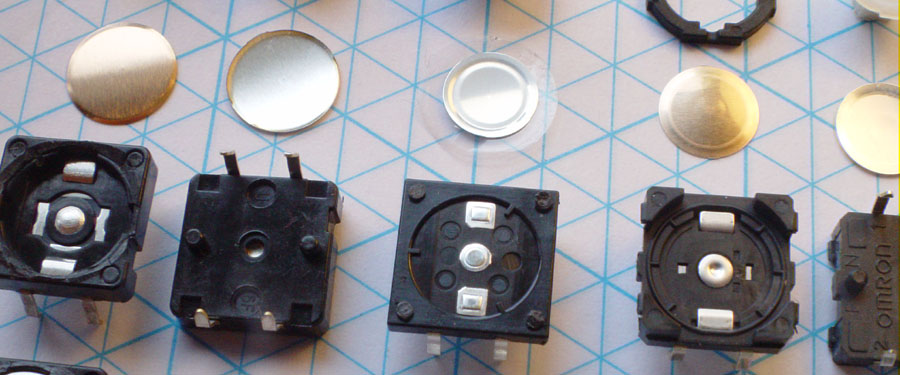
This shows the underside of the disc of the sealed ALPS switch.
Activation and holding forces
I made a little test jig which mounted the switch upside-down, on a piece of old TR-606 front panel board, such that when I applied force to the back of the board, the switch stem would be moved without any rocking or eccentric forces.
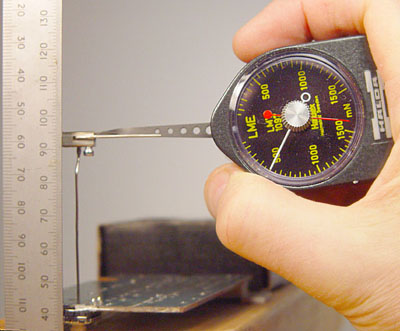
The Haldex (Halda) LMV 1097 force gauge is presumably pretty accurate. This one goes to 1.5 Newtons.
I used a digital scale to decide at what point of the arm the force should be taken from, and found it was about at the end of the tip. (It should be about 102 grams per Newton.) I attached a metal connector and drilled a hole in it, for the vertical bent paper-clip force transductor rod you see above. It is important to keep the arm, which moves according to the force, at right-angles to the transductor rod, and to keep this rod aligned with the axis of the switch.
The switch is inverted, sitting in the PCB, at the lower left.
Here are three videos of how I measured the forces. Its best to watch them in order, since the first one explains the concepts.
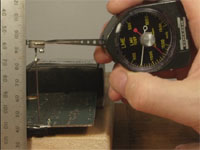
Testing forces for the unsealed ALPS switch (1:35)
Testing forces for the sealed ALPS switch (1:27)
Testing forces for the sealed Omron switch (1.43)
The raw results are in results.txt .
The averages appear in the table in the Summary section above, and here. The units are milli-Newtons:
force force force ratio
ALPS unsealed 1243 605 638 51.3%
ALPS sealed 1595 1305 290 18.2%
Omron sealed 1484 764 720 48.5%
It can be seen from these figures that the ALPS sealed switches (at least the ones we tested) have a much lower delta force and ratio – meaning there is not such a positive action of the switch staying down until quite a lot of the activation force is removed.
Measuring the displacements
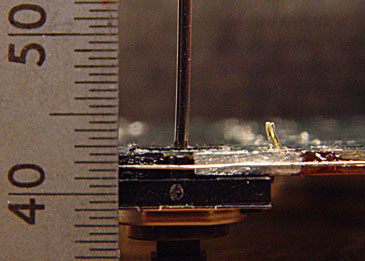
In the original camera image, after rotation, 10mm is represented by 640 pixels. So each pixel corresponds to 0.0156mm.
By pasting cropped versions of such images in a row, side to side, all in alignment vertically so their ruler part is exactly level with the left-most image, it is possible with Photoshop to measure the downward displacement of the PCB with the switch, in terms of pixels. If you want to look, PNG versions of the raw-camera-scale image, and a zoomed x 2 PNG version are named after each image. They are not hyperlinks - add them to the URL of this page if you want to see the file.
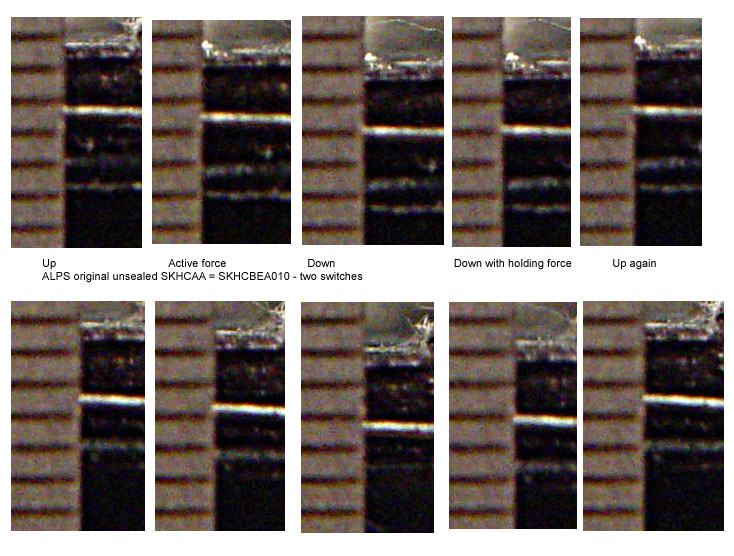
ALPS-non-sealed.png ALPS-non-sealed-zoom-x2.png
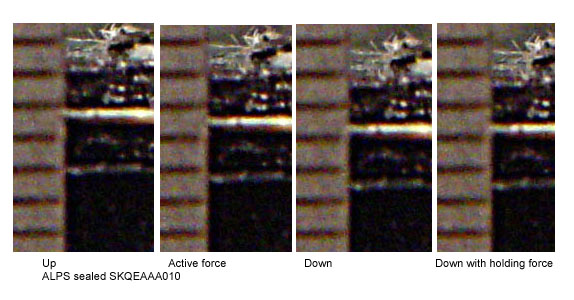
ALPS-sealed.png ALPS-sealed-zoom-x2.png
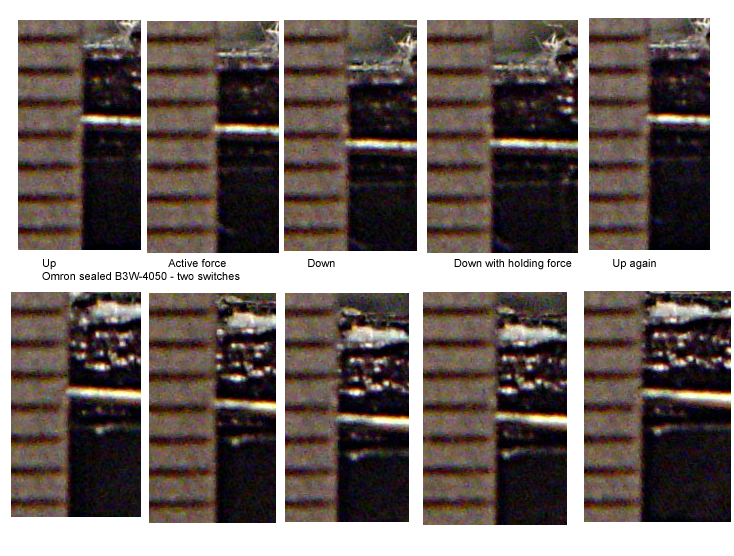
Omron-sealed.png Omron-sealed-zoom-x2.png
My original plan was to use a thin piece of wire-wrap wire as the pointer to track between the images. However, it became bent and was no longer horizontal. So I chose features of the edge of the PCB instead as reference points. I coloured the edge silver and then black, so it has some bright points.
To measure displacement, for instance for the second of the two Omron switches I tested, measuring the difference between the "Active force" position and the "Down" position, I used Photoshop to draw a rectangle between the same reference points on the two sub-images. The Info window then tells me the height of this in pixels, in this case 30. This is with the zoom-x2 file, where each pixel represents 0.0078125mm. So 30mm is 0.234mm.
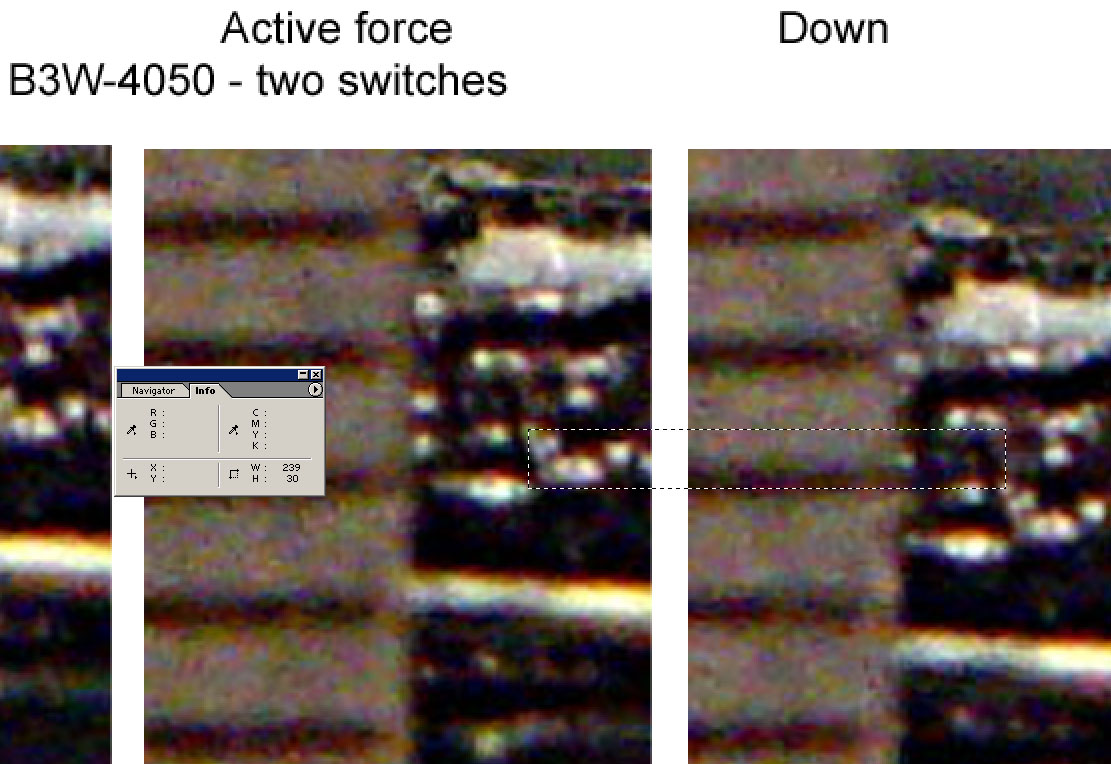
Here is a description of the displacements we might like to measure with a tact switch. All these are with reference to the Up state, in which no force is applied:
- "Active force" position. How far the stem moves when the
"Activation force" is applied. This is the force which is almost enough to
make the switch click downwards. This would be a combination of
metal disc deformation before it pops inwards, plus any elasticity in
the stem and whatever lies between the stem and the metal disc.
The unsealed ALPS switch has direct contact from the stem's plunger to
the metal disc. The sealed ALPS switch is similar. The
Omron switch has a 0.4mm thick piece of synthetic rubber, which I guess
would contribute significant elastic movement when something like the
Activation force is applied.
- Down position. After the switch clicks, and we are still applying the Activation force.
- Hold position, which may be somewhat above the Down position: how
far down the stem is when we relax the force, almost to the Holding
force, at which point the switch would click up again.
- Once it clicks upwards, if we still apply something like the
holding force, then the position may be somewhat higher then the
"Active force" position, due to elasticity.
The initial movement from being fully Up to the Active force position, is less important, since it is a smooth function of the increasing force as the force rises towards the Active force level. I call this the "Initial Displacement".
The individual results are in results.txt . The final results are:
ALPS unsealed 0.148mm 0.230mm
ALPS sealed 0.123mm 0.125mm
Omron sealed 0.164mm 0.234mm
With a lot more work, and switches from several batches, it would be possible to get more accurate figures. However, these figures are consistent with my perception that the ALPS sealed tact switches (not just the one I tested here, but all the ones I tried of the 100 I initially purchased) have a very small "Click Displacement" compared to the other two switches.
